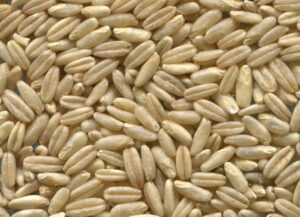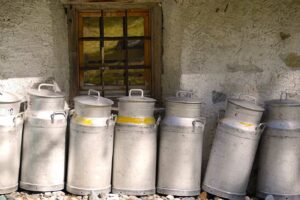Alvaro Garcia
Spelt (Triticum aestivum ssp. spelta) also known as dinkel wheat or hulled wheat, is a species of wheat (Triticum aestivum ssp. aestivum) that has been cultivated for over 8000 years. Common in Europe from the Bronze Age to the Medieval Ages, it survives now as a specialty crop in Central Europe and northern Spain.
According to genetic studies it originated as a naturally occurring hybrid of the early wild wheat (emmer; Triticum turgidum) and the wild goat-grass (Aegilops tauschii) even before the appearance of the common bread wheat. Its nutritive value is considered equal if not higher than common wheat. It seems to be resistant to environmental conditions where common wheat does not proper, having even lower nitrogen requirements.
It still retains however most of its characteristics from the past since it has not been genetically improved as intensely. It yields less per hectare, the stems/grain ratio is higher, and it requires additional dehulling than common flour wheat since these hulls represent close to 30% of the kernel.
Spelt is trendy as a healthy food
The recent world “healthy foods” movement has drawn attention back to this species, particularly in Austria, Germany, and Austria, as a specialty flour for human consumption. In other European countries however, it is still utilized as animal fodder particularly in its hulled form. There are also byproducts obtained from its processing for human food that can also be used as ruminant feed.
A very recent experiment (Sommerfeld et al. 2020) in Germany looked at the different fractions of spelt and their suitability as a feedstuff particularly for ruminants. The fractions evaluated were hulled spelt, spelt kernels and the hulls in terms of their chemical composition and nutritive value.
The study included six modern and traditional cultivars from three different locations to account for any differences. By taking this approach the researchers hoped to identify any differences in cultivar and/or location that affected the nutritive value of the different spelt fractions. Sowing date was in October and harvest in July 2011. The plots were treated once with Ariane C an herbicide containing fluroxypyr, florasulam, clopyralid at 1.5 L/Ha, then fertilized with 60 kg nitrogen/Ha (ammonium nitrate).
Field plots of 5 m2 were machine planted and harvested with a combine harvester. A subpart of each spelt sample was dehulled and then separated into three fractions: hulled spelt kernels, dehulled spelt kernels, and spelt hulls. Spelt kernels were then ground to pass through a 1-mm sieve; hulled spelt and spelt hulls to 0.75-mm.
Differences between fractions, cultivars or locations
For the spelt kernels there were differences between cultivars in crude protein (CP), lignin and starch, with the highest CP at 16.7% dry matter (DM), and a lowest starch of 65.9% DM. The lowest CP observed among cultivars was 12.8% DM and the highest starch at 73.2% DM.
No differences were observed between cultivars or locations for metabolizable energy (ME) and net-energy for lactation (NEL) concentrations, and digestible organic matter (OM). Starch concentration was negatively correlated in spelt kernels with CP (r = −.83), neutral-detergent-fiber (NDF; r = −.52), acid-detergent-fiber (ADF; r = −.73), and lignin (r = −.61).
Spelt kernels had more nutrients with higher ME, NEL, starch, and CP, and lower fiber fractions than the hulled spelt. Differences between cultivars were observed for CP, NDF, ADF, and lignin in the hulled spelt with the highest CP at 132 g/kg DM and the lowest at 103 g/kg DM.
Concentrations of analyzed macro- and microelements differed among cultivars and locations, except for P and Mn which only differed between locations. The highest ME was 12.0 MJ/kg DM, and the highest NEL was 7.6 MJ/kg DM. The highest and lowest ME and NEL values were 11.7 and 11.8 MJ ME/kg DM and 7.4 MJ NEL/kg DM, respectively.
As expected, starch was positively correlated with ME (r = .73) and negatively correlated with NDF (r = −.83), ADF (r = −.74) and lignin (r = −.51). The ME was negatively correlated with NDF (r = −.80), ADF (r = −.72) and lignin (r = −.67).
The results revealed that the constituents varied considerably and were affected by cultivars and/or location. Hulled spelt and spelt kernels of modern cultivars had more starch and energy and less crude protein and fiber fractions than older ones. Energy values for ruminants differed with cultivars particularly for hulled spelt but not for the kernels.
Different cultivars and locations affected chemical composition of spelt hulls particularly in fiber and ash. Pure spelt hulls showed very high concentration of fiber and ash with very little value as a feedstuff. It was only when approximately 20% kernel parts remained with the hulls that their metabolizable energy content for ruminants approached that of wheat straw.
Reference
V. Sommerfeld, H. Steingaß, C.F.H. Longin, M. Rodehutscord. 2020. Investigation on the variation of chemical composition and in vitro nutritive value of spelt (Triticum aestivum ssp. spelta) for ruminants. Journal of Animal Physiology and Animal Nutrition. Volume 104, Issue 2.
© 2020 Dairy Knowledge Center. All Rights Reserved.











